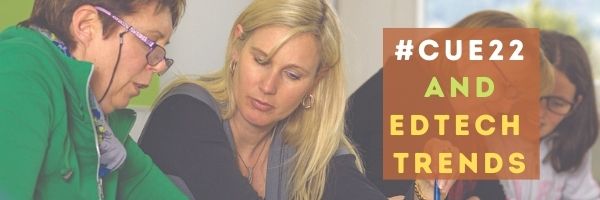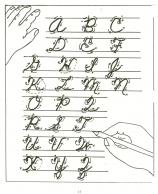If you attend edtech conferences, you know how motivating, energizing, and forward-thinking they are. I always come away feeling ready to use the latest and best edtech tools in my lesson plans. Ask a Tech Teacher contributor, Christian Miraglia, attended Spring CUE 22 in Palm Springs, California. Here are some of the great ideas he collected from colleagues and presenters:
#CUE22 and Trending Edtech
Conferences always bring new ideas, energy for changes in instructional practices, and new networking opportunities. I recently attended the Spring CUE 22 conference in Palm Springs, in which over two thousand educators gathered to share ideas, connect and view the latest in education technology. The CUE (Computer Users in Education) conference is the highlight event for California educators using technology. Much of the presentations indicated that changes are happening in classrooms spurred by the pandemic. Being that there were many topics of importance this post will focus on student agency with later posts focusing on feedback, E-Sports, and assessments.
Student agency is defined as learning in which students have a choice in relevant activities that represent their learning. Over my last three years in the classroom, I became a user of choice boards. These choice boards were for assessments in which students could choose from three content topics and three different ways of representing their learning. Borrowing from a Google Slide template shared by a fellow history teacher, I set up a slide deck that reviewed the content we covered with resources. Once students navigated through the learning process, they chose from three representation options to demonstrate their learning. Each option had a digital component, but if students preferred to create illustrations on paper, they only had to take a picture and submit it through the assignment portal.
Digital posters use essential vocabulary and images from the learning experience visually appealingly. Students use bullet points instead of paragraphs when summarizing the response. The three best platforms for these are Google Draw, Adobe Creative Cloud Express, and Canva.
The video option can utilize Adobe Creative Express, Flipgrid, WeVideo, and other screencasting platforms. Students represent their learning by using images and narration. The selection of the tool was based on the frequency of usage in my classroom. Students would often indicate they wanted to use another video tool not part of the original choice board. In keeping with the principle of student agency, this was always permissible.
Sketch and Tell is one of the formative and summative tools from EduProtocols. With Sketch and Tell, students create a digital drawing on one half of the Google or PowerPoint slide template representing a key concept from the unit and briefly explain how the image connects to the learning process on the other half of the template. I found that students who were artistically inclined opted for this representation. As with the two previously mentioned choices, students choose the method that fits their talents, thus giving agency to the learning process.
 Student agency is fostered beyond choice boards. Having students select their learning paths through an LMS is another method. Some teachers have also adopted the 20% Time or Genius Hour projects where students choose a subject beyond the scope of studies and dedicate twenty percent of the class to the project. Students can be creative, and innovative, and develop a more profound sense of purpose with these projects.
Student agency is fostered beyond choice boards. Having students select their learning paths through an LMS is another method. Some teachers have also adopted the 20% Time or Genius Hour projects where students choose a subject beyond the scope of studies and dedicate twenty percent of the class to the project. Students can be creative, and innovative, and develop a more profound sense of purpose with these projects.
While at the conference, I selected the sessions that best complimented my interest and learning style. The classroom should be no different in that students should have agency in how they submit work that best represents their individual talents. The days of just teaching content because that is what we do are over. Students at all levels are coming to school with a variety of experiences that can be captured by allowing choices in how they represent learning.
Bio
Christian Miraglia is a recently retired 36-year educator and now Educational Technology Consultant at t4edtech where he also blogs at Edtech and Things Related. He can be found on Twitter @T4edtech, Linkedin, and on his YouTube Channel Transformative Edtech.
Other Conferences Over the Years
- Teachers Pay Teachers’ July Conference — Overview
- 14 Action Items, 5 Take-aways and 3 Tidbits from the TpT Conference
- 18 Take-aways from ISTE–Observations, Tips and Great Digital Tools
- 12 Take-aways from WordCamp Orange County
- 9 Must-have Tools for Ed Conferences
Jacqui Murray has been teaching K-18 technology for 30 years. She is the editor/author of over a hundred tech ed resources including a K-12 technology curriculum, K-8 keyboard curriculum, K-8 Digital Citizenship curriculum. She is an adjunct professor in tech ed, Master Teacher, webmaster for four blogs, an Amazon Vine Voice, CSTA presentation reviewer, freelance journalist on tech ed topics, and author of the tech thrillers, To Hunt a Sub and Twenty-four Days. You can find her resources at Structured Learning.



































